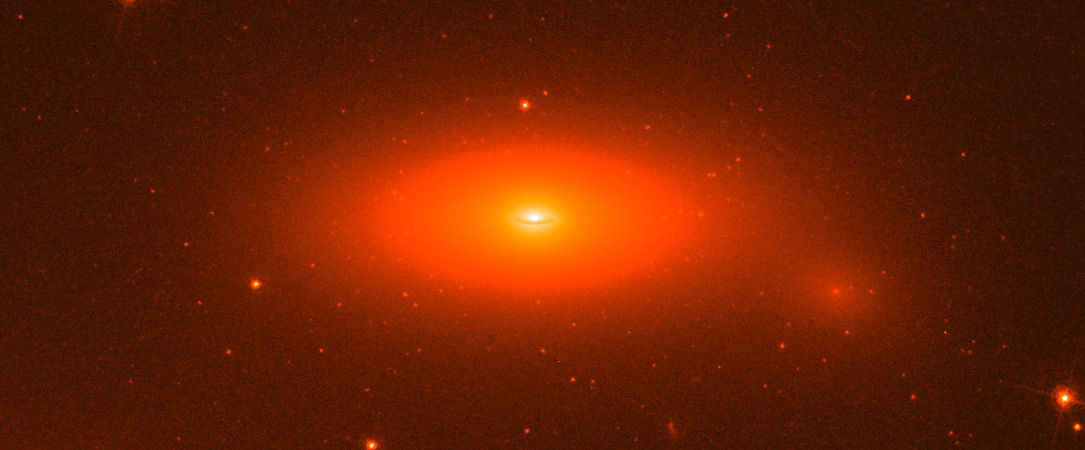https://academic.oup.com/mnras/article-lookup/doi/10.1093/mnras/stt840 wrote:
Is the black hole in NGC 1277 really overmassive?
Eric Emsellem
Mon Not R Astron Soc (2013) 433 (3): 1862-1870.
DOI:
https://doi.org/10.1093/mnras/stt840
Published: 20 June 2013
Abstract
<<A recent claim has been made by van den Bosch et al. that the fast-rotator galaxy NGC 1277 hosts an overmassive black hole with a mass (1.7 × 10
10 M
⊙) larger than half its (central) stellar spheroid mass. We revisit this claim here by examining the predictions from simple dynamical realizations based on new multi-Gaussian expansion (MGE) models of NGC 1277, using the same inclination i = 75°, and constant mass-to-light ratios. We present realizations which fit well the observed photometry taking into account an approximation for the extinction due to the central dust ring. The mass-to-light ratio M/L is fixed following scaling relations which predict a Salpeter-like initial mass function for such a luminous early-type fast rotator, 60 per cent higher than the one of the previously derived best-fitting model. A model without a black hole provides a surprisingly good fit of the observed kinematics outside the unresolved central region, but not, as expected, of the central dispersion and Gauss–Hermite h4 values. A model with a black hole mass of 5 × 10
9 M
⊙ allows us to fit the central dispersion profile, consistently with models of the same mass and M/L in van den Bosch et al. It departs from the central h4 values by only about twice the given uncertainty. A slightly varying M/L or the addition of high-velocity stars in the central spatially unresolved region would further lower the need for a very massive black hole in the central region of NGC 1277. These results do not, by themselves, rule out the presence of a presumed overmassive black hole at the centre of NGC 1277. However, they lead us to advocate the use of 3σ (as opposed to 1σ) confidence intervals for derived MBH as better, more conservative, guidelines for such studies. We also caution for the use of ill-defined spheroidal components as an input for scaling relations, and emphasize the fact that a MBH in the range 2–5 × 109 M
⊙ would represent less than 5 per cent of the spheroid bulge-like mass of our models and less than 2.5 per cent of its total stellar mass. This would make the black hole in NGC 1277 consistent or just twice as large as what a recent version of the MBH–σ predicts, well within the observed scatter. We examine the impact of the presence of an inner bar by running simulations from the same MGE model but with extreme anisotropies. An inner small (600 pc diameter) bar forms, and an end-on view does get closer to fitting the central dispersion profile (and fits the h3 amplitude) without the need for a central dark mass, while adding a black hole of 2.5 × 10
9 M
⊙, in line with the prediction from scaling relations, allows us to fit the dispersion peak and h3 profiles. Both models, however, still fail to fit the central h4 value (overpredicting the mean velocity). The claimed large mass of the presumed black hole therefore mostly relies on the measured positive high central h4 (at high dispersion), which can be associated with broad wings in the line-of-sight velocity distribution (high-velocity stars). This emphasizes the need to go beyond medium-resolution long-slit kinematics, with e.g. high-resolution integral-field spectroscopic data. In the specific case of NGC 1277, molecular or ionized gas kinematics (if present) within the central arcsecond (or at large scale) may provide a strong discriminant between these various models. We finally briefly discuss the fact that NGC 1277 resembles a scaled-up version of e.g. NGC 4342, another nearly edge-on fast rotator with a potentially large (but not overmassive) black hole.
INTRODUCTION
A recent claim has been recently made by van den Bosch et al. (2012) that the fast-rotator galaxy NGC 1277 hosts an overmassive black hole with a mass (17 ± 3 × 10
9 M
⊙) quoted as larger than half the stellar bulge mass. This departs very significantly from predictions of the so-called MBH–σ relation (see e.g. Tremaine et al. 2002), or the bulge–black hole mass relation. The best-fitting model including a relatively small size black hole (10
8 M
⊙) with respect to its spheroidal component, and using the same mass-to-light ratio, fails to fit e.g. the stellar velocity dispersion profile within the central 10 arcsec (see their fig. 3). This emphasizes the fact that a large 17 ± 3 × 10
9 M
⊙ black hole would influence the potential of the galaxy far out, a few hundreds of parsec from its central location. If confirmed, the existence of this overmassive black hole (relatively to the host galaxy) could either be a rare and exotic case, or would actually shed new light on the relation between the formation and evolution processes of early-type fast rotators and their central dark mass.
In this short paper, we revisit this claim by building simple dynamical models based on the multi-Gaussian expansion (MGE) technique (Emsellem, Monnet & Bacon 1994), also used in the modelling approach adopted by van den Bosch et al. (2012). The goal of the present paper is not to perform new fits to the observed data set. Here, we explore further what are the main constraints motivating the need for a very large black hole mass, and wish to examine whether other slight variations in the input assumptions may help reconcile the specific case of NGC 1277 with the above-mentioned scaling relations. We also examine the potential impact of an inner bar for the observed stellar kinematics of such a fast rotator (see e.g. Gerhard 1988), and more specifically its potential effect on the central stellar velocity dispersion. This could result in important diagnostics and in a near future help refute or confirm the claim of van den Bosch et al. (2012, hereafter vdB+12).>>

